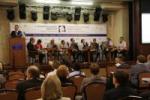The Left-Bank Hetmanate
The beginning of the 18th century was marked by the complication of the domestic and foreign political situation in Left Bank Ukraine. The Northern War between Russia and Sweden for the Baltic Sea coast resulted in the increase of economic pressure on the part of the Tsar's government on Ukrainian manufacturers. There was attraction of its human resources to participate in the military actions, fortifications and construction. The taxation burden was put not only on the ordinary Cossacks and peasants, but it also reached the social elite.
Ivan Mazepa (1644-1709), who was elected Hetman in 1687, acted on the opportunity of the Sweden invasion in Ukraine to take a risky step. Together with his confederates and four thousand Cossacks he united with the army of Karl XII in October 1708. An agreement was soon made between Ukraine and Sweden which provided for complete independence of Ukraine from "all foreign possession". Unfortunately, the general Ukrainian public, which had not been sufficiently informed about the Hetman's intentions, did not support his plans to stir up a rebellion against Peter I. In particular, peasants and common Cossacks feared to find their way to the yoke of Polish shliakhta. In addition, they did not want a renewal of rules which had existed on the entire Ukrainian territory since 1648. The mass repression on the part of the Tsar's troops pounced on those suspected of having relations with Mazepa. Hundreds of Cossacks and officers were persecuted and some of them were imprisoned or annihilated. Ivan Mazepa was declared a traitor and his name was anathematized. By the Tsar's command, the officers elected I. Skoropadskyi (1646-1722) as the new Hetman.
After the defeat of the Swedish Army near Poltava in June 1709 and the capitulation of Karl XII and his allies, the offensive of tsarism against the autonomy of the Hetmanate was executed much more quickly. The highest state posts in the Hetman's administration were given to people devoted to Peter I. First, Russian landlords appeared in Ukraine and they were the closest fellow warriors of the Russian emperor. Then middle gentry appeared. In 1709, the Zaporizhian Sich was destroyed. Thousands of Cossacks left for Turkey in search of refuge. The government of Peter I subsequently annihilated all the traces of the Ukrainian state system, and undermined the welfare of the Ukrainian people. It ruined the economic potential of Ukraine. During the elections of I. Skoropadskyi (1708), Peter I refused to sign traditional agreement articles between Russia and Ukraine. The new Hetman was practically deprived of the right to make independent decisions. The next step in limiting the rights of autonomy of Ukraine was the creation of the First Little Russia Collegium (1722), which became the chief managerial authority of the Hetmanate. The measures with regard to the successive liquidation of the local Cossack self-ruling were also taken in Slobodian, Ukraine. Such a policy of Peter I could not help but result in the resistance of the national elite that thought the idea of Ukrainian independence was still alive. It was manifested mostly in the Constitution by P. Orlyk, in which the preliminary experience of Ukrainian state existence had been generalized and the future ways of its development outlined. In the mid 1720s, P. Polubotok (about 1660-1724), was appointed Hetman and rose for the defense of the national state system of Ukraine. His plans were not supported by the demoralized society that was torn by social conflict.
Under the successors of Peter I, the relative consciousness in relations of the Russian monarchy with Ukraine altered with the strengthening of incorporation tendencies. The Little Russia Collegium was abolished under Peter I. In 1727, Ukrainians received permission to elect a new Hetman. D. Apostol (1654-1734), a colonel from Myrhorod, was elected as the new Hetman. During his hetmanship, he succeeded in realizing certain reforms such as perfecting the judicial system, securing the return of Cossacks to the Hetmanate, and he founded the "New Sich". All the activities of the Hetman were under the control of tsarist residents. He was deprived of the right to act in foreign policy and was subject to Russian General field marshal. Economic and legal prerogatives of the Hetman's power were also essentially limited. Tsarism began interfering with the affairs of Ukraine. The wave of protests to restore the hetmanship in Ukraine was expanded among other Cossack officers.
In 1750, K. Rozumovskyi (1728-1803) was elected as the last Hetman of Ukraine. In his domestic policy he reorganized the Cossack army, performed court reforms, and gathered meetings of Cossack officers. He also tried to pursue independent foreign policy that favored the transfer of Ukrainian problems from the jurisdiction of Senate to the Collegium of Foreign Affairs. He also applied for the liberation of Ukrainians from participation in military actions outside of Ukrainian territory. Catherine II disturbed this by the decrease in Rozumovskyi's authority and she decided to completely liquidate the hetmanship. The Second Little Russia Collegium was created in 1764. Its task was to completely liquidate the autonomy right which was still in use in the Left Bank Hetmanate. The attack of tsarism on the remains of Ukrainian autonomy entered its final phase in the 1770s and 1780s. By 1765 Catherine II had ordered the liquidation of Slobodian's Cossack army. The Slobodian Ukrainian province was organized there and was later included in the Kharkiv viceroyalty.
A Manifesto of August 3, 1775, proclaimed the liquidation of the Zaporizhian Sich. The socio-political system of Hetman Ukraine also underwent fundamental changes. In the early 1780s, its territory was divided into regions ruled by governor-generals and at this time the traditional court system was abolished. The force of the "Nobility Charter" was expanded to the Left Bank of Ukraine in 1785. General-imperial ruling authorities, standards, and customs were soon established. In essence, all of the organs and institutions of the Ukrainian state system were demolished.
By the end of the century, Ukraine had lost not only its political independence, but also its economic independence as a result of the economic policy of the Russian monarchy. The political and economic dependence on the Russian state was strengthened, and the Hetmanate lost the originality of its system. Serfdom was secured by law in the Left Bank and Slobodian Ukraine in 1783. This process was much quicker in South Ukraine, which was densely populated in the late 18th century. By 1796, the Russian government executed the existence of serfdom there.








